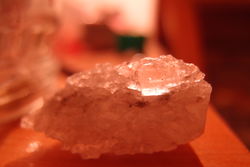Sodium chloride
 Rock salt - halite.
| |
| Names | |
|---|---|
| IUPAC name
Sodium chloride
| |
| Systematic IUPAC name
Sodium chloride | |
| Other names
Common salt
Halide Regular salt Rock salt Saline Salt Sea salt Table salt | |
| Properties | |
| NaCl | |
| Molar mass | 58.44 g/mol |
| Appearance | Colorless crystalline solid |
| Odor | Odorless |
| Density | 2.165 g/cm3 |
| Melting point | 801 °C (1,474 °F; 1,074 K) |
| Boiling point | 1,413 °C (2,575 °F; 1,686 K) |
| 35.65 g/100 ml (0 °C) 35.72 g/100 ml (10 °C) 36.00 g/100 ml (20 °C) 36.09 g/100 ml (30 °C) 36.37 g/100 ml (40 °C) 36.69 g/100 ml (50 °C) 37.04 g/100 ml (60 °C) 37.46 g/100 ml (70 °C) 37.93 g/100 ml (80 °C) 38.47 g/100 ml (90 °C) 38.99 g/100 ml (100 °C) | |
| Solubility | Insoluble in halocarbons, hydrocarbons |
| Solubility in ammonia | 2.15 g/100 ml (-40 °C) |
| Solubility in ethanol | 0.065 g/100 g (25 °C) |
| Solubility in ethylene glycol | 7.15 g/100 g (25 °C) |
| Solubility in formic acid | 5.21 g/100 g (25 °C) |
| Solubility in glycerol | 10 g/100 g (25 °C) |
| Vapor pressure | ~0 mmHg |
| Acidity (pKa) | 7 |
| Thermochemistry | |
| Std molar
entropy (S |
72.11 J·K−1·mol−1 |
| Std enthalpy of
formation (ΔfH |
−411.12 kJ/mol |
| Hazards | |
| Safety data sheet | Sigma-Aldrich |
| Flash point | Non-flammable |
| Lethal dose or concentration (LD, LC): | |
| LD50 (Median dose)
|
3,000 mg/kg (rat, oral) |
| Related compounds | |
| Related compounds
|
Lithium chloride Potassium chloride Rubidium chloride Caesium chloride |
| Except where otherwise noted, data are given for materials in their standard state (at 25 °C [77 °F], 100 kPa). | |
| Infobox references | |
Sodium chloride, sometimes referred to as table salt, is an inorganic compound and the sodium salt of hydrochloric acid, with formula NaCl. At room temperature it is a colorless or white crystalline solid. While most commonly known as a flavoring in numerous foods, sodium chloride finds substantial use as a chemical reagent.
Contents
Properties
Physical
Sodium chloride is a colorless or white crystalline solid with a cubic crystal structure. It has a salty taste, hence its use as table salt. A very fast way to cool a solution, apparatus, etc. is to immerse the object or container in ice and add salt; the dissolution of salt requires the ice to melt, pulling heat from its surroundings to initiate the phase change. Because table salt is inexpensive and readily available, this is a useful mechanism for generating a cooling bath for exothermic reactions or for dealing with emergency runaway situations.
Chemical
Sodium chloride can serve as a convenient source of either chloride or sodium ions in reaction mixtures, and can also be combined with concentrated sulfuric acid to generate hydrogen chloride or with dilute sulfuric acid to form hydrochloric acid in solution. Table salt is a common electrolyte for electrolysis, as it is a cheap pH neutral ionic compound. It can also be electrolyzed to produce, depending on the conditions, sodium hydroxide and chlorine gas, sodium chlorate, sodium perchlorate, or sodium hypochlorite, all enormously useful, but the process is not necessarily economical or efficient.
Availability
Suitably pure sodium chloride can be bought as uniodized (iodine-free) salt in grocery stores, or in bulk as water-softening tablets at hardware stores, by far the cheapest method. Some types of sodium chloride tablets are labeled 99.9% pure. It will often be sold in the grocery as "pickling salt", though pickling salt sometimes contains calcium. Iodized salt contains only a very small amount of iodide ion, and may not interfere in simple reactions. Though there are many different formulas for rock salt (used to de-ice roads), brands that contain only sodium chloride may be a good purchase for those that don't want to buy massive amounts of water purification tablets but also don't want to spend lots of money on food-grade salt.
Preparation
Though it is not economical to do so, sodium chloride is easily synthesized by neutralizing sodium bicarbonate, sodium carbonate, or sodium hydroxide with hydrochloric acid. It is the byproduct of the decomposition of sodium perchlorate, which also produces oxygen.
Sodium chloride will also be produced as side product in several reactions, such as the decomposition of sodium hypochlorite:
- 3 NaOCl → NaClO3 + 2 NaCl
Projects
- Make sodium hypochlorite/chlorate/perchlorate
- Make sodium hydroxide
- Make chlorine gas
- Make sodium metal (Downs process)
- Make cooling bath
- Grow crystals
Handling
Safety
Excess consumption of table salt has been linked with many illnesses. No safety measures are necessary when dealing with sodium chloride under normal conditions.
Storage
Sodium chloride should be stored in closed bottles, as it is slightly hygroscopic, though this mostly a problem if you live in a place with high air moisture. The container doesn't have to be air-tight though. Do not store it in metallic containers, as they might rust.
Disposal
Sodium chloride can be safely poured down the drain. Avoid dumping it in the ground in places where any useful plants grow, as it will kill plants. Pouring it in the ground into a jungle of stinging nettles, hogweed or other vile weeds is okay.